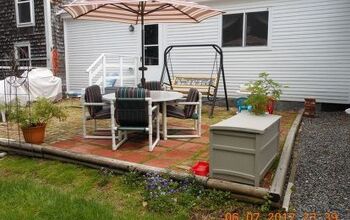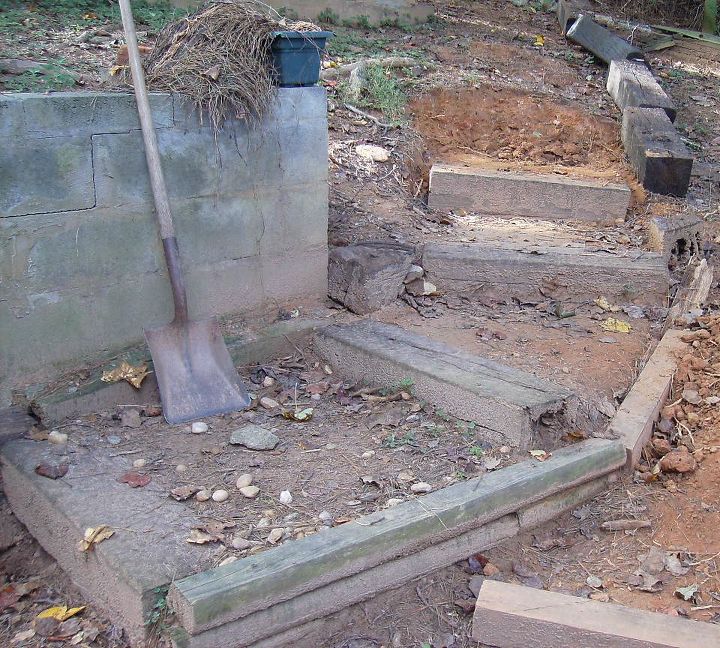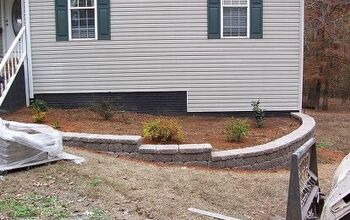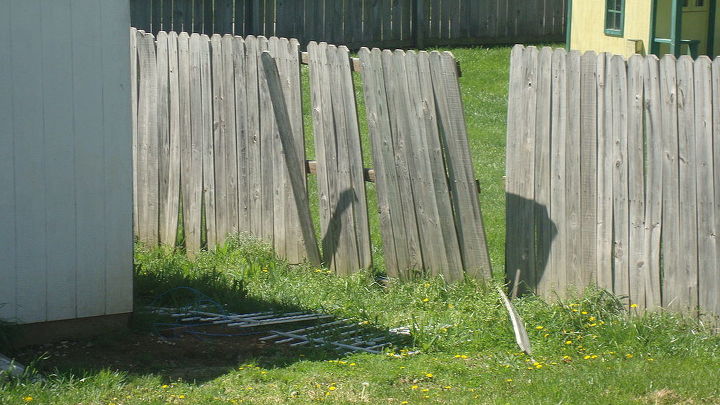I'm digging steps out of a hill and need suggestions

-
For the left side I would keep the continuity going with the railroad ties where there isn't any concrete & maybe a little grading to make sure the dirt doesn't go over the top You could possibly pour a concrete curb in those areas but I don't see that blending as well
 SLS Construction & Building Solutions LLC
on Sep 04, 2014
Helpful Reply
SLS Construction & Building Solutions LLC
on Sep 04, 2014
Helpful Reply -
-
I agree w SLS Construction to keep it going…HOWEVER you could use decorative stone in the Garden Bed and stack some by the RR ties too. Keeping the soil off the steps! Mulch is too lightweight and will probably wash out during rainstorms…. P.S. BTW My family has been into landscaping for 50+ years
 DebLynn
on Sep 05, 2014
Helpful Reply
DebLynn
on Sep 05, 2014
Helpful Reply -
-
You are building a high maintenance project, I would have built a walk way that goes from top to bottom. steps like these are not good , too much chance to get hurt
 Don Payne
on Sep 05, 2014
Helpful Reply
Don Payne
on Sep 05, 2014
Helpful Reply -
-
I don't understand what kind of walkway you mean. Without steps, I can just walk up or down the hill but with some danger of falling since it's somewhat steep.
 Louise
on Sep 05, 2014
Helpful Reply
Louise
on Sep 05, 2014
Helpful Reply -
-
I was just at the Porcupine Mountains in Michigan, and a trailhead down from a lookout bluff started out identical to what you describe you are doing for your steps! But I've no recall of what they did to retain soil on the sides and have no pics showing it. :( An option might be stacked brick/pavers or fieldstone (depending on the look you wanted) - quickcrete or masonry adhesive would hold them in place until the ground settled. Regardless - I like the step idea and I think its going to be beautiful and highly functional!
 Melanie Hinman
on Sep 05, 2014
Helpful Reply
Melanie Hinman
on Sep 05, 2014
Helpful Reply -
-
Using the railroad ties is probably the best idea, as it will blend in better with the stairs. You could also build mini walls from block (like the retaining walls), as you go on the left side of the stairs. That way, you can change the look of the wall by paint, stucco, facing it with faux rock, etc. A masonry wall will last much longer than wood in the long run, too. You can plant trailing plants to cover part of the wall, as a matter of fact you can actually plant the wall itself if you fill with soil at the top! Maybe those plants won't get trampled or dug up (I have dogs too) since they're next to the stairs. Fill the bottom layer with some concrete and rebar pieces to anchor them in place, then just butter the next block row with mortar mix. Btw, you're doing a great job!! It will be beautiful when it is done!
 Debra Grieve
on Sep 05, 2014
Helpful Reply
Debra Grieve
on Sep 05, 2014
Helpful Reply -
-
If you go to "concrete" on Hometalk you will find some wonderful suggestions for your wall. Your steps look great, my son-in-laws built similar steps leading down to the lake. Good job.
 Christine Willson
on Sep 05, 2014
Helpful Reply
Christine Willson
on Sep 05, 2014
Helpful Reply -
-
What about using landscape fabric with egg rock and other rocks for added interest to the wall?
 Becky H
on Sep 05, 2014
Helpful Reply
Becky H
on Sep 05, 2014
Helpful Reply -
-
I built a step system just like this a few years back. I lined the sides with a decorative Stone border and made the stone border higher than the walkway about 3" taller. For the sides, planted some flowering shrubs and a bulb garden filling it it with washed pebbles. It was low maintenance and yet a nice nature walk.
 Shar
on Sep 05, 2014
Helpful Reply
Shar
on Sep 05, 2014
Helpful Reply- See 2 previous
-
-
You're creating a gully for rain to funnel through. You need to block the flooding at the top on the right with more retaining wall AND dig out the area on the right to keep it from flowing back in on that side, too. Your project started out too deep from the very first step at the top.
 Beth Bourque
on Sep 05, 2014
Helpful Reply
Beth Bourque
on Sep 05, 2014
Helpful Reply- See 1 previous
-
-
I like the idea of using railroad timbers on both sides. I'd also recommend having your steps slope slightly to the right (as you look up) for proper drainage, so water doesn't pool on the steps. I also recommend using smallish river rock on these steps, otherwise it will be hazardous to walk on. Our neighbor recenlty added ~4" river rock in their backyard, and it's not very stable for walking. In some cases where the soil is a lot taller on the left, you may want to put a concrete layer under the railroad timber, or stack 2 timbers with the top one extending into the slope more to create the base for the next level. If you have a lot of deciduous trees, know that you will end up with debris in your rocks and will end up pulling trees, bushes, weeds, etc. over the years. If you can afford flagstone or other rock surfaces for the steps, that would mean less maintenance over the years.
 Connie Mar
on Sep 05, 2014
Helpful Reply
Connie Mar
on Sep 05, 2014
Helpful Reply -
-
Connie is correct...the river rock is difficult to walk on and can be unstable. Smaller pit run or crushed rock (or a flat stone if possible) would be better with a good weed block underneath. You might find yourself pulling weeds out of your rocks more often than you'd like. Low maintenance is always a good idea to keep in mind. Good luck!
 Dudley Right
on Sep 05, 2014
Helpful Reply
Dudley Right
on Sep 05, 2014
Helpful Reply -
-
Sorry, Louise. I wasn't trying to pick them apart and criticize, but there is a major engineering flaw that will cause your entire project to wash away when you have your first major rainstorm. I don't know about you, but that would devastate me after so much hard work. The steps look like they are a gutter waiting for rain TO ME. Maybe I'm just not seeing it the right way. Sorry again. You really are a hard worker to take this on. Good going.
 Beth Bourque
on Sep 05, 2014
Helpful Reply
Beth Bourque
on Sep 05, 2014
Helpful Reply -
-
Slices of branches or small trees would look nice to fill up that step area or slate.
 Tris Smith
on Sep 05, 2014
Helpful Reply
Tris Smith
on Sep 05, 2014
Helpful Reply -
-
Don't listen to those buzz killers. You are bad to the bone to have gotten that far. I helped build a gigantic park here in this area that it looks a lot like your yard. Brown pine needles and pine bark ( inexpensive). Slate, free standing or cemented in place with moss in the cracks. I get a lot of material in the trash around town. Cement with marbles embedded or other mosaic colors and shapes. Rope handles to hold on to, rope linked through holes in 4x4.
 Peggy Gama
on Sep 05, 2014
Helpful Reply
Peggy Gama
on Sep 05, 2014
Helpful Reply -
-
P.S. Important: Standing water. dig little trenches to make the water drain where you want it.
 Peggy Gama
on Sep 05, 2014
Helpful Reply
Peggy Gama
on Sep 05, 2014
Helpful Reply -
-
You can use 5/4 Cedar planking horizontally to hold the hill. This is really 1 1/4 inch thick and will hold the dirt well. 1 inch will also work. Smooth or rough will work fine. Drive 2-3 foot pieces of rebar steel (the stuff you use in cement) into the ground . Drive is so it it just below the top of the wood. Fasten the rebar to the cedar with electrical plastic clamps and deck screws or stainless steel screws (no rusting this way). Have these on the back so the dirt can cove the rebar. Another way is to sink the rebar as above, use short 4X4 cedar posts you have drilled out length wise. Slide them over the rebar and then bolt the cedar planks to the cedar posts. Use galvanized lag bolts with washers as the bolts. I hope this makes since. I do not like to use red wood as it splinters easily.
 Bruce Armstrong
on Sep 05, 2014
Helpful Reply
Bruce Armstrong
on Sep 05, 2014
Helpful Reply -
-
An inexpensive way to prevent the soil from washing would be to work lengths of garden hose throughout the soil before planting and mulching. Use long "spikes" to hold them in place. They do not deteriorate and can be well hidden with mulch. 20+ years ago, I, with the help of my husband did this using granite stone! I know how much work it is. Do slope the steps ever so slightly for quick drainage.
 Joan
on Sep 05, 2014
Helpful Reply
Joan
on Sep 05, 2014
Helpful Reply -
-
Good luck! Big job! Particularly in the heat we have been having!
 Jeanette S
on Sep 06, 2014
Helpful Reply
Jeanette S
on Sep 06, 2014
Helpful Reply -
-
I admire you for your major undertaking. It is a challenging job and as you are going, looks like you are up to the challenge ! Go for it! I have cemented steps on a bank, then had to redo as they pulled apart, down the hill. Built patio on slope, and steps on slope. No great photos but will share some. Only advice I can give you is to anchor the timbers, drill holes in them and pound in metal rebar. The long drill bit and metal rebar are cheap. The rebar should go into the soil about 2-3 feet. It will hold everything in place and even keep your timbers from rolling on their sides. A cross piece at the top is very helpful, as is sloping the ground away from your steps. I cheer you on, having lived on a hill where every side is "down hill" sharing some of my attempts to make it useable land
 Susan Cryor
on Sep 06, 2014
Susan Cryor
on Sep 06, 2014






 Helpful Reply
Helpful Reply -
-
I would recommend putting small river rock into the narrow space beside the steps. If you pack enough rock into that area, it acts as a French Drain and slows the flow of water and lets some of it percolate into the soil. And I agree, that putting river rock on the top of the steps sounds rough to walk on, even if you pound them down into the dirt. If it was mine and the budget was tight (as it usually is!) I would put one of the concrete steps they sell at box stores for about 88 cents apiece and put river rock around it. The slate, however, is a better option if you can afford it. Great work...I wish my old body could make that kind of effort in my hilly area.
 Bonny McDaniel
on Sep 06, 2014
Helpful Reply
Bonny McDaniel
on Sep 06, 2014
Helpful Reply -
-
It looks like a lot of work! No suggestions just encouragement, yours and mine! When I see what other people are facing it inspires me to get off my couch. Best to you !
 Wendy Johnson
on Sep 06, 2014
Helpful Reply
Wendy Johnson
on Sep 06, 2014
Helpful Reply -
-
You are doing a great job.. Keep going til you chisel out the steps as you see them in your vision and then you can decide what works best with the sides to retain the dirt. If the dirt is compact red chert/clay it may not wash much if you chop it away straight on the sides ... Its gonna work out great. and you will be proud of the accomplishment once you are done!
 Buster Evans
on Sep 06, 2014
Helpful Reply
Buster Evans
on Sep 06, 2014
Helpful Reply -
-
ON THE SIDES WHERE THE SOIL IS HIGHER THAN THE STEPS, USE ROCKS TO MAKE MINI WALLS TO HOLD THE SOIL BACK. THEN PLANT PLANTS IN THE CRACKS. THAT IS WHAT I DID AT ONE SIDE OF MY DRIVEWAY. I ALSO LIKE THE FRENCH DRAIN IDEA WITH THE ROCK SLABS OR CONCRETE IN THE MIDDLE. GOOD LUCK! I DID MY DRIVEWAY WHEN I WAS 65,
 DORLIS
on Sep 07, 2014
Helpful Reply
DORLIS
on Sep 07, 2014
Helpful Reply- See 1 previous
-
-
That looks like a lot of work. We have a similar back yard and we struggleto go up and down. So we don’t much withit, except mow. We had a small wallbuilt professionally in the front so I would have a level place to plant shrubsand flowers. Here are somepictures. The first shows how the bedwas when we bought the house. Anotherpicture shows the process of trenching and laying tubes and gravel. The last one shows the finished wall. I know the drainage is important when rightnext to the house. I wish you luck. We don’t have the energy anymore for aproject of this magnitude.
 Liliana Wells
on Sep 08, 2014
Helpful Reply
Liliana Wells
on Sep 08, 2014
Helpful Reply -
-
LOUISE I HAVE NOT MASTERED THAT YET. STILL WORKING ON IT.
 DORLIS
on Sep 09, 2014
Helpful Reply
DORLIS
on Sep 09, 2014
Helpful Reply -
-
Here's another idea for holding soil in place. I had to have a creek bank rebuilt. The contractors used "burritos" made of soil wrapped in coir fabric. They laid down a layer of fabric with excess hanging down the bank, placed soil on it, packed it down, and then folded the fabric back over the soil. There are about six or seven such layers stair-stepped up the bank. Small trees were laid horizontally on each layer before the next was added. The tree roots have grown into the fabric. You might be able to do something similar on your smaller scale with sturdy landscaping fabric, poking holes for perennials such as sedums or other ground covers which will eventually hold the soil in place.
 Martha
on Sep 11, 2014
Helpful Reply
Martha
on Sep 11, 2014
Helpful Reply -
-
In picture #3, it looks like there is a cement/masonry wall farther up from the one you built..can you tie the 2 together? or somehow build a wall that will separate the steps from the higher side? What you can do with this area After you have a wall built is to fill it in with the dirt that you shovel out for the steps....afterwards, at a later date, you can make this area a flower &/or veggie garden maybe... To make sure that your work does not get washed away, drill holes in the landscape timbers & then drive rebar thru the holes & into the ground...I would suggest 18 inch to 24 inch long rebar & 3/4 inch thick(the rebar).this will not only help to hold the timbers in place, but the soil as well.
 Capernius
on May 19, 2015
Helpful Reply
Capernius
on May 19, 2015
Helpful Reply -
Related Discussions
GNATS - How to get rid of them?
Somehow my house and garden got tiny gnats that killed my fuchsia plant and fly everywhere. I have tried ALL the Web recommendations - soap and oil dishes, sand in th... See more
Marigolds growing! Should I pinch the buds?
My marigold plants are growing. I heard that pinching the buds until Autumn will allow them to grow without killing the plant. Is this true?
Growing garlic
Growing our first garlic, should we wait until the leaves are drying out before we pick it? Husband picked first one today along with our first potatoes.
How to keep mice out of your garden?
Hi everyone, I have mice in my garden destroying my vegetables and I have also noticed them in the barn and shed. Please can someone tell me how to prevent them from ... See more
What's the best flower/plant to grow in Texas?
I know that opinions vary, but what's your opinion?!I have great luck w Rosemary plants. Green all year long.
Best way to kill bush/tree after being cut down?
Just moved into a new home. There was a huge thorny bush dragon devouring the mailbox. I slayed the dragon but it is trying to rise up again. How can I make sure it's... See more
Nightmare neighbors
We have the worst neighbors ever! They complain about everything! They hate dogs so they complain every time our dogs bark one time (not exaggerating) they have fabri... See more














